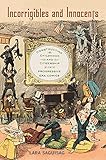Incorrigibles and Innocents : Constructing Childhood and Citizenship in Progressive Era Comics / Lara Saguisag.
Material type: TextPublisher: New Brunswick, NJ : Rutgers University Press, [2018]Copyright date: ©2019Description: 1 online resource (252 p.) : 50 color picturesContent type:
TextPublisher: New Brunswick, NJ : Rutgers University Press, [2018]Copyright date: ©2019Description: 1 online resource (252 p.) : 50 color picturesContent type: - 9780813591773
- 9780813591803
- Children in literature
- Citizenship in literature
- Comic books, strips, etc -- United States -- History and criticism
- Literature and society -- United States -- History
- SOCIAL SCIENCE / General
- childhood, citizenship, comics, Progressive Era, The Yellow Kid, Buster Brown, The Katzenjammer Kids, Little Nemo in Slumberland, Little Ah Sid, Jap "It", Made the Magician's Daughter, Betsy Bouncer and Her Doll, comic books, graphic novels, comic strips
- 741.5/973 23
- PN6725 .S35 2019
- online - DeGruyter
- Issued also in print.
| Item type | Current library | Call number | URL | Status | Notes | Barcode | |
|---|---|---|---|---|---|---|---|
 eBook
eBook
|
Biblioteca "Angelicum" Pont. Univ. S.Tommaso d'Aquino Nuvola online | online - DeGruyter (Browse shelf(Opens below)) | Online access | Not for loan (Accesso limitato) | Accesso per gli utenti autorizzati / Access for authorized users | (dgr)9780813591803 |
Browsing Biblioteca "Angelicum" Pont. Univ. S.Tommaso d'Aquino shelves, Shelving location: Nuvola online Close shelf browser (Hides shelf browser)

|

|

|

|

|

|

|
||
| online - DeGruyter Embodying the Problem : The Persuasive Power of the Teen Mother / | online - DeGruyter Familiar Perversions : The Racial, Sexual, and Economic Politics of LGBT Families / | online - DeGruyter Comics Studies : A Guidebook / | online - DeGruyter Incorrigibles and Innocents : Constructing Childhood and Citizenship in Progressive Era Comics / | online - DeGruyter Transitive Cultures : Anglophone Literature of the Transpacific / | online - DeGruyter Food Across Borders / | online - DeGruyter No Slam Dunk : Gender, Sport and the Unevenness of Social Change / |
Frontmatter -- CONTENTS -- INTRODUCTION -- Chapter 1. FOREIGN YET FAMILIAR -- Chapter 2. CROSSING THE COLOR LINE -- Chapter 3. FAMILY AMUSEMENTS -- Chapter 4. THE "SECRET TRACTS" OF THE CHILD'S MIND -- Chapter 5. WHAT WOULD YOU DO WITH GIRLS LIKE THESE? -- CONCLUSION. Naughty Boys in a New Millennium -- ACKNOWLEDGMENTS -- NOTES -- BIBLIOGRAPHY -- INDEX -- ABOUT THE AUTHOR
restricted access online access with authorization star
http://purl.org/coar/access_right/c_16ec
Histories and criticism of comics note that comic strips published in the Progressive Era were dynamic spaces in which anxieties about race, ethnicity, class, and gender were expressed, perpetuated, and alleviated. The proliferation of comic strip children-white and nonwhite, middle-class and lower class, male and female-suggests that childhood was a subject that fascinated and preoccupied Americans at the turn of the century. Many of these strips, including R.F. Outcault's Hogan's Alley and Buster Brown, Rudolph Dirks's The Katzenjammer Kids and Winsor McCay's Little Nemo in Slumberland were headlined by child characters. Yet no major study has explored the significance of these verbal-visual representations of childhood. Incorrigibles and Innocents addresses this gap in scholarship, examining the ways childhood was depicted and theorized in late nineteenth- and early twentieth-century comic strips. Drawing from and building on histories and theories of childhood, comics, and Progressive Era conceptualizations of citizenship and nationhood, Lara Saguisag demonstrates that child characters in comic strips expressed and complicated contemporary notions of who had a right to claim membership in a modernizing, expanding nation.
Issued also in print.
Mode of access: Internet via World Wide Web.
In English.
Description based on online resource; title from PDF title page (publisher's Web site, viewed 30. Aug 2021)


